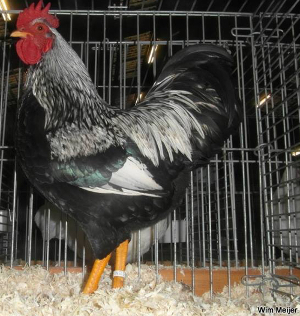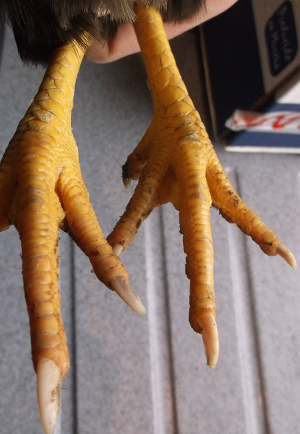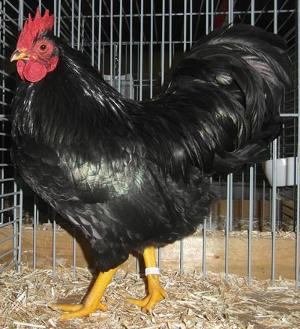By Neil Armitage Published on
Barnevelder breed standard

How the Barnevelder should look:
The breed standard for the Barnevelder was first written in 1921 and has changed a little since. The first Barnevelder to be standardised and the most common is the double laced Barnevelder. There are now six colours of Barnevelder, White, brown and black as well as blue double laced and silver in both bantam and full size. The breed standard varies depending on where you are in the world. For an overview of the barnevelder breed click here.
It is important to remember that there is always perspective in how breed standards are interpreted. Both by the individual and the judge. Hopefully you will be a little wiser of what is required of the breed. As always let me know what you think and bear in mind that standards are different the world over - these are just a guide!
The colours allowed are different in the Barnevelder standards, depending on where you show your birds, but the look of the bird is the same across both the full size and the bantam and I hope I haven't lost anything in the translation:
Below: A silver laced Barnevelder cockerel in a show cage.

This is a good example with nice shape and good carridge, bright yellow legs and lovely sheen on the feathers.
Head: Carried high with a neat skull.
Beak: Short and full.
Eyes: Very bold, bright and prominent.
Comb: Single, medium size, carried erect, well serrated and with a firm base. The heel must follow the neck.
Wattles: Medium for size.
Earlobes: Long-shaped.
Face: Smooth, unfeathered, or at most a slight sign of feathering.
Neck: Fairly long and full, carried erect.
Breast and Rump: Deep, broad and full.
Back: Medium length and broad.
Feathering: Fairly tight throughout and of nice texture.
Appearance: Alert, compact and well-balanced.
Wings: Rather short, carried high.
Legs: Thigh and shank of medium length to give symmetry.
BUILD OF THE HEN.
As in the cock, with differences due to gender.
COLOUR OF THE COCKEREL.
Neck: Black with red, neck-hackle black, ending in red, and red stem with a broad black tip.
Breast: Black (beetle-green).
Back: Red-brown feathers with very wide black lacing.
Abdomen and Thighs: Black, with dark down.
Winqs: Wing coverts, red-brown with broad black lacing. Flight coverts, black.
Secondaries: inner edge, black; outer edge red-brown, showing when closed as a red- brown bar.
Primaries: inner edge black, outer edge red-brown.
Wing Bows: Black (beetle-green), with wide red centre.
Saddle: Black, with red. Hackles black ending red, with a black tip.
Tail: All main feathers black, with beetle-green sickles and hangers.
Beak: Yellow, with dark point.
Face: Red.
Eyes: Orange.
Leg Colour: Yellow.
Lobes: Red.
Appearance: All black feathers and lacing which are visible to show beetle-green sheen.
Neck: Black. A little brown in the upper part is permissible.
Breast: Broadly laced, black (beetle-green) feather with red-brown centre.Saddle and Back: Double-laced with broad outer edging of black (beetle-green).
Abdomen and Thighs: Black, with black down preferred.
Wings: Flight coverts, black. Secondaries: inner edge, black; outer edge, red-brown. Primaries: Inner edge, black; outer edge, red-brown. When wing is closed a red-brown bar is formed.
Black, with a little red-brown in the tail coverts.
Legs: Yellow desirable.
COLOUR OF THE HEN (Partridge Variety).
Neck: Black, a little brown in the upper part is permissible.
Breast: Broadly laced black (beetle- green) feather, with red-brown ground, peppered with black and with narrow brown shaft. A black feather with wide brown centre stripe is permissible.
Back, Saddle and Wing Bows: Broadly laced, black (beetle-green) feather, with red-brown ground, peppered with black. A narrow brown shaft is permissible. Flight Coverts, Secondaries and Primaries: Black ground, peppered with brown, showing a uniform appearance.
Tail: Black, coverts peppered.
Legs: Yellow desirable.
SERIOUS DEFECTS.
White in lobes. Squirrel, or wry tail. Feathered legs or toes, Sidesprigs. Crooked toes. High or roached backs. Seriously deformed breast bones. More than four toes on either foot. Black legs.
MINOR DEFECTS.
White in under-colour, flights, tail, wings, sickles or fluff.
I have added a little more below, mostly as i didn't really know where to put it:
The barnevelder is a medium heavy bird with a concave back line. Horizontal stance with a length to depth ratio of 3:2 and a wide deep and full body.
Wide shoulders with a closed tight fitting wing carried quite high and horizontally.
Medium length neck with full ruff hanging to the shoulders.
The back is medium length and broad with a wide saddle and climbs to the tail.
The Barnevelder should have a broad well developed belly and a deep well rounded and slightly bulging or proud chest.
The Barnevelder head is medium sized but wider and deeper than normal with a single comb, fine and smooth with 4 to 6 teeth, although the preference is for 5 . Overly large or floppy comb or to many or to few teeth is a fault. The Barnevelder was first bred to cope with the cold northern climate and the smaller comb and winter egg production was a bonus.
Red earlobe and medium well rounded wattles separate from the neckline. Vivid and bright orange eyes with a short strong and arched beak , darker at the base and yellow at the tip. White lobes are a fault in Barnevelders.
Average leg length with broad yellow legs and strong visible thighs and well spread toes.
Below: Barnevelders have sturdy legs and a proud stance, the legs should always be yellow.

Yellow legs with straight well formed toes and even nails.
The breed standard for the Barnevelder hen are much the same apart from the gender differences but include a wide full belly. Gross errors are a lack of body depth or width, flat back, a high or narrow stance and a large comb or a flat or wry tail.
My overriding feeling about the breed is the hens are quite full figured and full in the body and should feel heavy. The Barnevelder hen is a full figured lady eminently suitable for burlesque ( my addition, that bit wasn't in the original standards of the breed). The Barnevelder is pleasing to the eye.
SCALE OF POINTS. Total - 100
Type and Size .30
Colour . . 25
Textur . . 15
H Ctid .. . 10
Legs and Feet .10
Health and Condition .10
Plumage :In the double laced Barnevelder the plumage on the head should be black with a petrol green shimmer and brown wing panels in the cockerel only. The lacing should be well defined with no spots in the lacing. With the colours the feathers should have even colour. The colours in the feather should be even and uniform with clearly defined margins and no peppering or spots.
In the under colour of the feathers white is a minor fault and darker under colour is preferred. White patches are a fault.

The picture shows a young Barnevelder cockerel with good face and comb and the correct 3:2 body ratio , visible thighs and the green sheen is clearly visible in his feathers.
The Pullet has the same ratio as well as the full rounded body and well spread toes. You can see the black head feathers and the sheen on her feathers. Vivid orange eyes and fine ( small ) comb.
The egg standard for the Barnevelder:There is some misinformation about the colour of the Barnevelder egg. It has never been really dark like the Marans. There would be little point if all brown egg layers produced the same shade of dark brown egg, there would be nothing to differentiate the breeds.
The egg is best described as golden brown ( Hans Schippers) or coffee brown. it should weight 60 to 65 grams and have a solid shell. Beside that the normal criteria for selecting eggs stands. Free from blemishes, ridges and cracks. In My experience the best eggs come from birds allowed to range with food available.
About The Barnevelder Breed:
Barnevelders are heavy birds with smaller wings placed high on the body which makes them poor flyers, ours weight in between 6.5 and 8.5 lb although our 3 year old barnevelder cockerel tops the scale at 15 lb which is probably a bit big for the standards.
The Barnevelder makes excellent pets because of their good nature and calm disposition. For his size, he is easy to handle and can be picked up and petted and will eat from our hands. Unusually for chickens, Barnevelder cockerels make good fathers and several of our help in rearing the chicks, even with brooding.
Although not a regular broody the Barnevelder is a natural mother and approximately 1/6 of our flock go broody during warm weather in spring and summer.
Barnevelders are robust birds that cope well with all weather including ice and snow and almost uniquely amongst chickens they continue to lay eggs all winter albeit at a slower rate, barnies are happiest as free range birds as then can be a bit lazy if kept enclosed.
The Barnevelder is a good forager and find a lot of their own food if allowed to range, free ranging seems to improve the quality and quantity of the speckled brown eggs.
Barnevelders lay approximately 200 brown speckled eggs per year. They are excellent quality eggs that can weight up to 3 oz and have a really solid shell.
Barnevelder eggs are not as dark as they were, the breeding for show has resulted in slightly lighter coloured eggs but they are still speckled.
Our birds prefer to nest outside although not all like to be able see out of the nest
